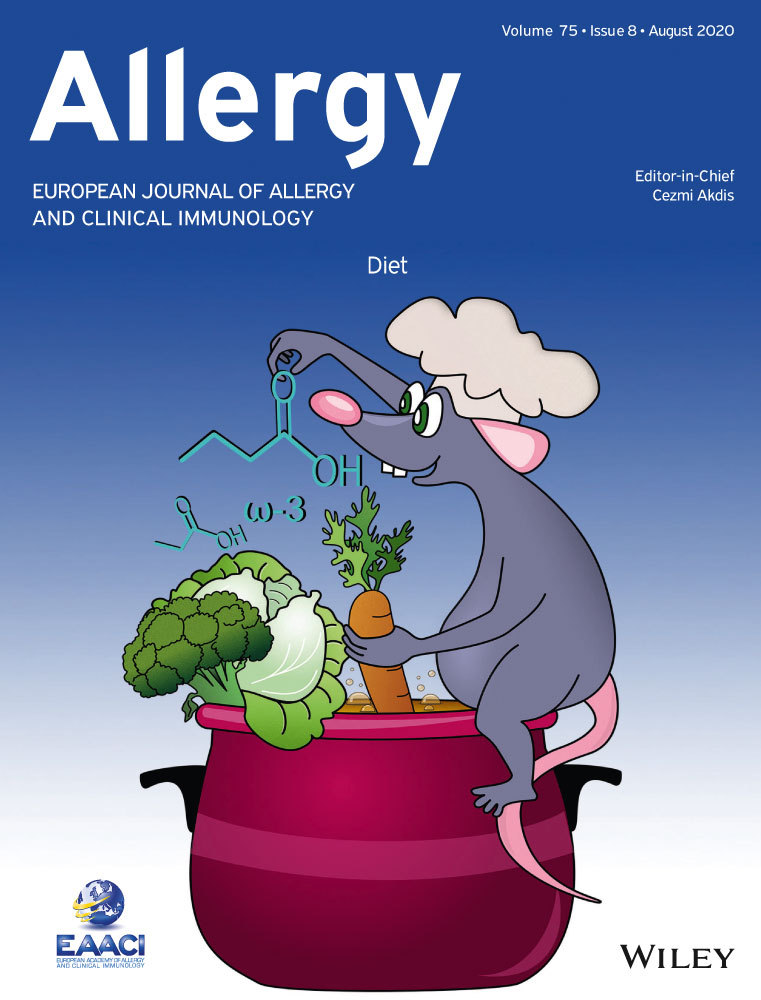Potential treatment effect of the SQ tree SLIT-tablet on pollen food syndrome caused by apple
Corresponding Author
Stephen J. Till
Peter Gorer Department of Immunobiology, School of Immunology and Microbial Sciences, School of Medicine, Guys Hospital, Kings College London, London, UK
Correspondence
Stephen J. Till, Peter Gorer Department of Immunobiology, School of Immunology and Microbial Sciences, School of Medicine, Guys Hospital, Kings College London, London SE1 9RT, UK.
Email: [email protected]
Search for more papers by this authorBrian Sonne Stage
Global Clinical Development, ALK, Hørsholm, Denmark
Search for more papers by this authorIsabel Skypala
Royal Brompton & Harefield NHS Foundation Trust, Imperial College London, London, UK
Search for more papers by this authorTilo Biedermann
Department of Dermatology and Allergology, Technical University of Munich, Munich, Germany
Clinical Unit Allergology, Helmholtz Zentrum Munich, German Research Center for Environmental Health GmbH, Neuherberg-Munich, Munich, Germany
Search for more papers by this authorCorresponding Author
Stephen J. Till
Peter Gorer Department of Immunobiology, School of Immunology and Microbial Sciences, School of Medicine, Guys Hospital, Kings College London, London, UK
Correspondence
Stephen J. Till, Peter Gorer Department of Immunobiology, School of Immunology and Microbial Sciences, School of Medicine, Guys Hospital, Kings College London, London SE1 9RT, UK.
Email: [email protected]
Search for more papers by this authorBrian Sonne Stage
Global Clinical Development, ALK, Hørsholm, Denmark
Search for more papers by this authorIsabel Skypala
Royal Brompton & Harefield NHS Foundation Trust, Imperial College London, London, UK
Search for more papers by this authorTilo Biedermann
Department of Dermatology and Allergology, Technical University of Munich, Munich, Germany
Clinical Unit Allergology, Helmholtz Zentrum Munich, German Research Center for Environmental Health GmbH, Neuherberg-Munich, Munich, Germany
Search for more papers by this author
Supporting Information
| Filename | Description |
|---|---|
| all14242-sup-0001-FigS1.jpgJPEG image, 75.7 KB | Fig S1 |
| all14242-sup-0002-FigS2.jpgJPEG image, 87.3 KB | Fig S2 |
| all14242-sup-0003-TableS1.pdfPDF document, 41 KB | Table S1 |
| all14242-sup-0004-Supinfo.docxWord document, 26.5 KB | Supinfo |
Please note: The publisher is not responsible for the content or functionality of any supporting information supplied by the authors. Any queries (other than missing content) should be directed to the corresponding author for the article.
REFERENCES
- 1Werfel T, Asero R, Ballmer-Weber BK, et al. Position paper of the EAACI: food allergy due to immunological cross-reactions with common inhalant allergens. Allergy. 2015; 70(9): 1079-1090.
- 2Biedermann T, Winther L, Till SJ, Panzner P, Knulst A, Valovirta E. Birch pollen allergy in Europe. Allergy. 2019; 74(7): 1237-1248.
- 3Geroldinger-Simic M, Zelniker T, Aberer W, et al. Birch pollen-related food allergy: clinical aspects and the role of allergen-specific IgE and IgG4 antibodies. J Allergy Clin Immunol. 2011; 127(3): 616-622.
- 4Matricardi PM, Kleine-Tebbe J, Hoffmann HJ, et al. EAACI molecular allergology user's guide. Pediatr Allergy Immunol. 2016; 27(suppl 23): 1-250.
- 5Muraro A, Roberts G, Worm M, et al. Anaphylaxis: guidelines from the European academy of allergy and clinical immunology. Allergy. 2014; 69(8): 1026-1045.
- 6Blankestijn MA, Knulst AC, Knol EF, et al. Sensitization to PR-10 proteins is indicative of distinctive sensitization patterns in adults with a suspected food allergy. Clin Transl Allergy. 2017; 7: 42.
- 7Biedermann T, Kuna P, Panzner P, et al. The SQ tree SLIT-tablet is highly effective and well tolerated: results from a randomized, double-blind, placebo-controlled phase III trial. J Allergy Clin Immunol. 2019; 143(3): 1058-1066.
- 8Kinaciyan T, Jahn-Schmid B, Radakovics A, et al. Successful sublingual immunotherapy with birch pollen has limited effects on concomitant food allergy to apple and the immune response to the Bet v 1 homolog Mal d 1. J Allergy Clin Immunol. 2007; 119(4): 937-943.




